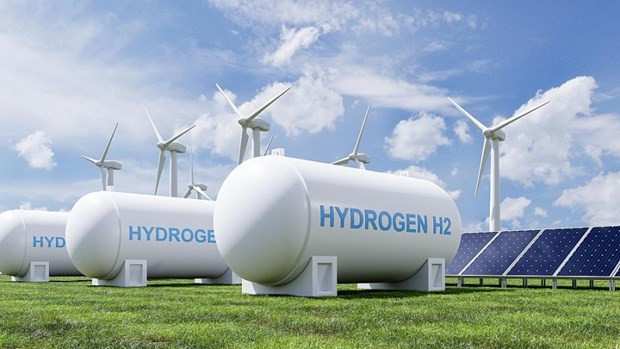Việt Nam is well-positioned for GH2 production
Experts said Việt Nam has a large and diverse renewable energy industry, proximity to major importers in the Asia- Pacific region, strong renewable energy resource potential and low political risk.
Green hydrogen (GH2) industrial development is a direction for Việt Nam in the energy transition roadmap to achieve the goal of zero carbon emissions by 2050 but challenges remain, experts said.
According to experts at the workshop on policy framework for renewable energy development and the potential for green hydrogen in Việt Nam, held by GIZ in co-operation with the Electricity and Renewable Energy Authority under the Ministry of Industry and Trade, with the support of the German Federal Ministry for Economic Affairs and Climate Action (BMWK), Việt Nam has a large and diverse renewable energy industry, proximity to major importers in the Asia- Pacific region, strong renewable energy resource potential and low political risk.
The GH2 produced from the electrolysis of water using renewable energy will play an important role in the reduction of greenhouse gas emissions towards the net zero carbon goal that the world and Việt Nam are pursuing in line with the commitments in COP 26.
Ali Habib, an international consultant, told the workshop: "Việt Nam was well-positioned for the production, but policy and partnerships will be essential to ensure success."
Võ Thanh Tùng, a project expert with GIZ Energy Support Programme, said that renewable energy technologies, such as wind and solar power, have developed strongly in recent years, which opens up new opportunities to promote the development of the green hydrogen industry.
Many countries worldwide have developed strategies for the green hydrogen industry, setting specific mid- and long-term goals and ambitions to develop the domestic consumption market. Japan, South Korea, Germany, and EU countries also plan to import hydrogen from neighbouring countries and the region.
In addition, an important geopolitical factor stemming from the Ukraine - Russia conflict has also spurred the development of this industry because green hydrogen can store clean energy for a long time, helping to ensure energy security. It is also considered a very important factor today in Europe.
"Việt Nam is a country with abundant potential for solar power and wind power onshore or offshore, so it is assessed to have great potential to produce green hydrogen for domestic consumption and domestic industries. It has the potential to export to the international market, contributing to reducing greenhouse gas emissions and promoting the development of the green hydrogen industry in the future," said Tùng.
At the workshop, experts pointed out limited land availability compared to other major potential exporting countries, such as Australia, Chile, and Morocco, as well as lower resource quality than some of the other potential competitors, in particular solar, greater geographic distance to the EU (and hence, higher GH2 shipping cost) and higher cost of capital than many other potential exporting countries such as Australia or Chile were challenging Việt Nam in the production of GH2.
Under such a circumstance, Việt Nam's policies and partnerships are essential for success, said experts.
They suggested Việt Nam establish clear long-term targets for the production of green hydrogen, seek out strategic partnerships with major importing countries like Japan and Germany for the production of green hydrogen, introduce favourable tax and fiscal rules for green hydrogen production, and explore the introduction of feed-in tariffs for green hydrogen production fed into the natural gas network and develop monitoring and certification protocols to ensure compliance with international standards.
At the same time, they urged the country to establish an industrial cluster designated for hydrogen production and research.
Việt Nam was recommended to introduce standards for the injection of green hydrogen into natural gas infrastructure, provide fiscal incentives for industries to shift their hydrogen or ammonia consumption to green hydrogen, introduce policies to encourage green hydrogen use in key sectors such as shipping as well as adopt carbon pricing: carbon pricing helps make green hydrogen more cost-competitive against grey hydrogen.
Held in Hà Nội last week, the workshop discussed international trends in renewable energy development policies towards the net-zero target, international experiences in the related areas, and global trends for new technological solutions – green hydrogen.
The workshop was within the framework of BMWK's visit to Việt Nam from November 28 to 30 to foster the relationship between the two countries through dialogues about policy framework development for renewable energy, the potential of green hydrogen in Việt Nam, setting up an energy efficiency club, as well as meeting with German businesses in Việt Nam.
Since 2013, energy has become one of the priorities of Vietnamese-German cooperation, establishing the GIZ Energy Support Programme, a partnership between Việt Nam's Ministry of Industry and Trade (MOIT) and the Deutsche Gesellschaft für Internationale Zusammenarbeit (GIZ) GmbH.
The programme aims to contribute to Việt Nam's emissions reduction and green growth strategy by improving the existing regulatory framework for Renewable Energy and Energy Efficiency to foster private sector investment and by increasing key institutions and stakeholders' professional and organisational capacities.






